Comprehensive Survey on VLC in E-Healthcare: Channel Coding Schemes and Modulation Techniques
Abstract
1. Introduction
2. Effects of Electromagnetic Fields (EMFs) on Health
3. Modulation Techniques for VLC in E-Healthcare Systems
3.1. On–Off Keying (OOK)
3.2. Pulse Amplitude Modulation (PAM) and Quadrature Amplitude Modulation (QAM)
3.3. Orthogonal Frequency-Division Multiplexing (OFDM) and Advanced Modulation Techniques for Improved Efficiency
3.4. Modulation Techniques for MIMO Approaches in VLC
3.5. Modulation Techniques in IEEE 802.15.7-2018 Standard and Their Adaptation to E-Health Environments
4. Channel Coding Schemes for Error Correction in VLC in E-Healthcare Scenarios
4.1. Reed–Solomon and LDPC Codes in VLC
4.2. Turbo Codes and Polar Codes
4.3. Advanced Coding Techniques for Dimmable VLC Systems
4.4. Run-Length Limited (RLL) Codes
5. Integration of VLC in Healthcare Environments
6. Future Directions and Challenges
6.1. Mitigating the Effects of Electromagnetic Interference (EMI)
6.2. Channel Coding Optimization
6.3. Resource Allocation and Spectrum Efficiency
6.4. Environmental Impact on VLC Systems
6.5. Hybrid VLC-RF Systems for E-Healthcare
6.6. Energy Efficiency and Real-Time Processing
7. Conclusions
Author Contributions
Funding
Institutional Review Board Statement
Informed Consent Statement
Data Availability Statement
Conflicts of Interest
Abbreviations
| AAO-OFDM | asymmetrically clipped absolute value optical |
| orthogonal frequency-division multiplexing | |
| ACO-OFDM | asymmetrically clipped optical |
| orthogonal frequency-division multiplexing | |
| ALACO-OFDM | adaptive layered asymmetrically clipped optical |
| orthogonal frequency-division multiplexing | |
| BER | bit error rate |
| CAN | controller area network |
| CDF | cumulative distribution function |
| CT | computerized tomography |
| DCM | discontinuous conduction mode |
| DCO-OFDM | direct current-biased optical |
| orthogonal frequency-division multiplexing modulation | |
| DNA | deoxyribonucleic acid |
| EMF | electromagnetic field |
| EMFT | electromagnetic field therapy |
| EMR | electromagnetic radiation |
| FER | frame error rate |
| FOV | field of view |
| GSM | graphical information category scale marking |
| HACO-OFDM | hybrid asymmetrically clipped optical |
| orthogonal frequency-division multiplexing | |
| HB-LED | high-brightness light-emitting diodes |
| IM/DD-OFDM | intensity modulation and direct detection |
| orthogonal frequency-division multiplexing modulation | |
| ISI | inter-symbol interference reduction |
| LACO-OFDM | layered asymmetrically clipped optical |
| orthogonal frequency-division multiplexing | |
| LDPC | low-density parity check |
| LEDs | light-emitting diodes |
| LSTM | long short-term memory networks |
| MATLAB | matrix laboratory |
| MIMO | multiple input, multiple output |
| MPs | mobile phones |
| MRI | magnetic resonance imaging |
| M-QAM | multilevel quadrature amplitude modulation |
| MW | microwave |
| OOK | on–off keying |
| PAM | pulse amplitude modulation |
| PAM-DMT | pulse-amplitude-modulated discrete multitone modulation |
| probability density function | |
| PWM | pulse width modulation |
| QAM | quadrature amplitude modulation |
| QCM | quadrature carrier multiplexing |
| RF | radio frequency |
| RLL | run-length limited |
| RNNs | recurrent neural networks |
| SAR | specific absorption rate |
| SDRs | software-defined radios |
| SMP | spatial multiplexing |
| SNR | signal-to-noise ratio |
| STBCs | space–time block codes |
| UART | microcontroller—universal asynchronous receiver/transmitter |
| US | ultrasound |
| USRP | universal software radio peripheral |
| VLC | visible-light communication |
References
- Ng, X.W.; Chung, W.Y. VLC-based medical healthcare information system. Biomed. Eng. Appl. Basis Commun. 2012, 24, 155–163. [Google Scholar] [CrossRef]
- Candia, D.A.; Játiva, P.P.; Azurdia Meza, C.; Sánchez, I.; Ijaz, M. Performance Analysis of the Particle Swarm Optimization Algorithm in a VLC System for Localization in Hospital Environments. Appl. Sci. 2024, 14, 2514. [Google Scholar] [CrossRef]
- Matheus, L.E.M.; Vieira, A.B.; Vieira, L.F.; Vieira, M.A.; Gnawali, O. Visible light communication: Concepts, applications and challenges. IEEE Commun. Surv. Tutor. 2019, 21, 3204–3237. [Google Scholar] [CrossRef]
- Al Hasnawi, R.; Marghescu, I. A Survey of Vehicular VLC Methodologies. Sensors 2024, 24, 598. [Google Scholar] [CrossRef] [PubMed]
- Iturralde, D.; Guaña-Moya, J.; Játiva, P.P.; Sánchez, I.; Ijaz, M.; Dehghan Firoozabadi, A.; Zabala-Blanco, D. A new Internet of things hybrid VLC/RF System for m-Health in an underground mining industry. Sensors 2023, 24, 31. [Google Scholar] [CrossRef]
- Hussain, B.; Li, X.; Che, F.; Patrick Yue, C.; Wu, L. Visible light communication system design and link budget analysis. J. Light. Technol. 2015, 33, 5201–5209. [Google Scholar] [CrossRef]
- Bajwa, J.; Munir, U.; Nori, A.; Williams, B. Artificial intelligence in healthcare: Transforming the practice of medicine. Future Healthc. J. 2021, 8, e188–e194. [Google Scholar] [CrossRef]
- Khan, F.; Jan, S.R.; Tahir, M.; Khan, S. Applications, limitations, and improvements in visible light communication systems. In Proceedings of the 2015 International Conference on Connected Vehicles and Expo (ICCVE), Shenzhen, China, 19–23 October 2015; IEEE: Piscataway, NJ, USA, 2015; pp. 259–262. [Google Scholar]
- Fernández, B.; Játiva, P.P.; Azurdia-Meza, C.A.; Boettcher, N.; Zabala-Blanco, D.; Gaitán, M.G.; Soto, I. Performance Analysis of a VLC System Applied to a Hospital Environment for IoT-Based Smart Patient Monitoring. In Proceedings of the 2024 14th International Symposium on Communication Systems, Networks and Digital Signal Processing (CSNDSP), Rome, Italy, 17–19 July 2024; IEEE: Piscataway, NJ, USA, 2024; pp. 615–620. [Google Scholar]
- Song, J.; Ding, W.; Yang, F.; Yang, H.; Wang, J.; Wang, X.; Zhang, X. Indoor hospital communication systems: An integrated solution based on power line and visible light communication. In Proceedings of the 2014 IEEE Faible Tension Faible Consommation, Monaco City, Monaco, 4–6 May 2014; IEEE: Piscataway, NJ, USA, 2014; pp. 1–6. [Google Scholar]
- Webber, J.; Mehbodniya, A.; Teng, R.; Arafa, A.; Alwakeel, A. Finger-gesture recognition for visible light communication systems using machine learning. Appl. Sci. 2021, 11, 11582. [Google Scholar] [CrossRef]
- Rehman, S.U.; Ullah, S.; Chong, P.H.J.; Yongchareon, S.; Komosny, D. Visible light communication: A system perspective—Overview and challenges. Sensors 2019, 19, 1153. [Google Scholar] [CrossRef]
- Kavitha, V.; Vijayalakshmi, B.A.; VanithaLakshmi, M.; wankhede, J. VLC-based DCO-OFDM and WSN in hospitals for medical information transmission. J. Opt. 2024, 53, 1–9. [Google Scholar] [CrossRef]
- Anitha Vijayalakshmi, B.; Senthil Kumar, A.; Kavitha, V.; Ravikumar, D. Transmitting patient’s health care information using LEDs in hospitals through VLC technology. J. Opt. 2024, 53, 1–8. [Google Scholar] [CrossRef]
- Garaj-Vrhovac, V.; Gajski, G.; Pažanin, S.; Šarolić, A.; Domijan, A.M.; Flajs, D.; Peraica, M. Assessment of cytogenetic damage and oxidative stress in personnel occupationally exposed to the pulsed microwave radiation of marine radar equipment. Int. J. Hyg. Environ. Health 2011, 214, 59–65. [Google Scholar] [CrossRef] [PubMed]
- Lai, H.; Singh, N.P. Melatonin and a spin-trap compound block radiofrequency electromagnetic radiation-induced DNA strand breaks in rat brain cells. Bioelectromagn. J. Bioelectromagn. Soc. Soc. Phys. Regul. Biol. Med. Eur. Bioelectromagn. Assoc. 1997, 18, 446–454. [Google Scholar] [CrossRef]
- Zeni, O.; Di Pietro, R.; d’Ambrosio, G.; Massa, R.; Capri, M.; Naarala, J.; Juutilainen, J.; Scarfì, M.R. Formation of reactive oxygen species in L929 cells after exposure to 900 MHz RF radiation with and without co-exposure to 3-chloro-4-(dichloromethyl)-5-hydroxy-2 (5H)-furanone. Radiat. Res. 2007, 167, 306–311. [Google Scholar] [CrossRef]
- Hook, G.J.; Spitz, D.R.; Sim, J.E.; Higashikubo, R.; Baty, J.D.; Moros, E.G.; Roti Roti, J.L. Evaluation of parameters of oxidative stress after in vitro exposure to FMCW-and CDMA-modulated radiofrequency radiation fields. Radiat. Res. 2004, 162, 497–504. [Google Scholar] [CrossRef]
- Schüz, J.; Jacobsen, R.; Olsen, J.H.; Boice, J.D., Jr.; McLaughlin, J.K.; Johansen, C. Cellular telephone use and cancer risk: Update of a nationwide Danish cohort. J. Natl. Cancer Inst. 2006, 98, 1707–1713. [Google Scholar] [CrossRef]
- Lagroye, I.; Hook, G.; Wettring, B.; Baty, J.; Moros, E.; Straube, W.; Roti Roti, J. Measurements of alkali-labile DNA damage and protein–DNA crosslinks after 2450 MHz microwave and low-dose gamma irradiation in vitro. Radiat. Res. 2004, 161, 201–214. [Google Scholar] [CrossRef]
- Köylü, H.; Mollaoglu, H.; Ozguner, F.; Nazỳroölu, M.; Delibap, N. Melatonin modulates 900 Mhz microwave-induced lipid peroxidation changes in rat brain. Toxicol. Ind. Health 2006, 22, 211–216. [Google Scholar] [CrossRef]
- Röösli, M.; Egger, M.; Pfluger, D.; Minder, C. Cardiovascular mortality and exposure to extremely low frequency magnetic fields: A cohort study of Swiss railway workers. Environ. Health 2008, 7, 35. [Google Scholar] [CrossRef]
- Boyle, J. Wireless technologies and patient safety in hospitals. Telemed. J. E-Health 2006, 12, 373–382. [Google Scholar] [CrossRef]
- Tan, K.S.; Hinberg, I.; Wadhwani, J. Electromagnetic interference in medical devices: Health Canada’s past and current perspectives and activities. In Proceedings of the 2001 IEEE EMC International Symposium. Symposium Record. International Symposium on Electromagnetic Compatibility (Cat. No. 01CH37161), Montreal, QC, Canada, 13–17 August 2001; IEEE: Piscataway, NJ, USA, 2001; Volume 2, pp. 1283–1288. [Google Scholar]
- Chen, M.; Gonzalez, S.; Vasilakos, A.; Cao, H.; Leung, V.C. Body area networks: A survey. Mob. Netw. Appl. 2011, 16, 171–193. [Google Scholar] [CrossRef]
- Zamanian, A.; Hardiman, C. Electromagnetic radiation and human health: A review of sources and effects. High Freq. Electron. 2005, 4, 16–26. [Google Scholar]
- Mangini, F.; Frezza, F.; Batool, S.; Bibi, A. Benefits and hazards of electromagnetic waves; telecommunication, physical and biomedical: A review. Eur. Rev. Med. Pharmacol. Sci. 2019, 23, 3121–3128. [Google Scholar]
- Van Den Berg, P.M.; De Hoop, A.; Segal, A.; Praagman, N. A computational model of the electromagnetic heating of biological tissue with application to hyperthermic cancer therapy. IEEE Trans. Biomed. Eng. 1983, 12, 797–805. [Google Scholar] [CrossRef]
- Chaussy, C.G.; Fuchs, G.J. Current state and future developments of noninvasive treatment of human urinary stones with extracorporeal shock wave lithotripsy. J. Urol. 1989, 141, 782–789. [Google Scholar] [CrossRef] [PubMed]
- Jimenez, H.; Blackman, C.; Lesser, G.; Debinski, W.; Chan, M.; Sharma, S.; Watabe, K.; Lo, H.W.; Thomas, A.; Godwin, D.; et al. Use of non-ionizing electromagnetic fields for the treatment of cancer. Front. Biosci. (Landmark Ed.) 2018, 23, 284–297. [Google Scholar]
- Mostafa, J.; Ali, Y.; Zohre, R.; Samaneh, R. Electromagnetic fields and ultrasound waves in wound treatment: A comparative review of therapeutic outcomes. Biosci. Biotechnol. Res. Asia 2015, 12, 185–195. [Google Scholar] [CrossRef]
- Jajte, J.; Zmyślony, M.; Palus, J.; Dziubałtowska, E.; Rajkowska, E. Protective effect of melatonin against in vitro iron ions and 7 mT 50 Hz magnetic field-induced DNA damage in rat lymphocytes. Mutat. Res./Fundam. Mol. Mech. Mutagen. 2001, 483, 57–64. [Google Scholar] [CrossRef] [PubMed]
- Mortazavi, S.; Safari, A.; Khavanin, A.; Kazemnejad, A.; Moazzeni, S.; Abbas, R. Induction of micronuclei in mice lymphocytes exposed to microwave and toluene. Am. J. Appl. Sci. 2005, 2, 1321–1324. [Google Scholar] [CrossRef][Green Version]
- Karinen, A.; Heinävaara, S.; Nylund, R.; Leszczynski, D. Mobile phone radiation might alter protein expression in human skin. BMC Genom. 2008, 9, 77. [Google Scholar] [CrossRef]
- Alkis, M.E.; Bilgin, H.M.; Akpolat, V.; Dasdag, S.; Yegin, K.; Yavas, M.C.; Akdag, M.Z. Effect of 900-, 1800-, and 2100-MHz radiofrequency radiation on DNA and oxidative stress in brain. Electromagn. Biol. Med. 2019, 38, 32–47. [Google Scholar] [CrossRef] [PubMed]
- Bortkiewicz, A.; Gadzicka, E.; Zmyślony, M. Heart rate variability in workers exposed to medium-frequency electromagnetic fields. J. Auton. Nerv. Syst. 1996, 59, 91–97. [Google Scholar] [CrossRef] [PubMed]
- Tattersall, J.E.; Scott, I.R.; Wood, S.J.; Nettell, J.J.; Bevir, M.K.; Wang, Z.; Somasiri, N.P.; Chen, X. Effects of low intensity radiofrequency electromagnetic fields on electrical activity in rat hippocampal slices. Brain Res. 2001, 904, 43–53. [Google Scholar] [CrossRef]
- Ismail, S.N.; Salih, M.H. A review of visible light communication (VLC) technology. AIP Conf. Proc. 2020, 2213, 020289. [Google Scholar]
- Van Der Zwaag, K.M.; Marinho, M.P.; Costa, W.D.S.; Dos Santos, F.D.A.S.; Bastos-Filho, T.F.; Rocha, H.R.; Segatto, M.E.; Silva, J.A. A Manchester-OOK visible light communication system for patient monitoring in intensive care units. IEEE Access 2021, 9, 104217–104226. [Google Scholar] [CrossRef]
- Kumari, M.; Sharma, R.; Sheetal, A. A hybrid next-generation passive optical network and visible light communication for future hospital applications. Optik 2021, 242, 166978. [Google Scholar] [CrossRef]
- Ali, S. Employing VLC technology for Transmitting Data in Biological Tissue. Master’s Thesis, University of Oulu, Oulu, Finland, 2019. [Google Scholar]
- Chen, C.; Yang, H.; Du, P.; Zhong, W.D.; Alphones, A.; Yang, Y.; Deng, X. User-centric MIMO techniques for indoor visible light communication systems. IEEE Syst. J. 2020, 14, 3202–3213. [Google Scholar] [CrossRef]
- Fernandes, V.; Parab, J.; Pinto, C.; Naik, G.M. Li-Fi Transmission and Reception in Visible and IR Light in a Hospital Environment. In Data Science and Intelligent Computing Techniques; SCRS: New Delhi, India, 2023; pp. 197–208. [Google Scholar]
- Ding, W.; Yang, F.; Yang, H.; Wang, J.; Wang, X.; Zhang, X.; Song, J. A hybrid power line and visible light communication system for indoor hospital applications. Comput. Ind. 2015, 68, 170–178. [Google Scholar] [CrossRef]
- Soto, I.; Zamorano-Illanes, R.; Becerra, R.; Játiva, P.P.; Azurdia-Meza, C.A.; Alavia, W.; García, V.; Ijaz, M.; Zabala-Blanco, D. A new COVID-19 detection method based on CSK/QAM visible light communication and machine learning. Sensors 2023, 23, 1533. [Google Scholar] [CrossRef]
- Játiva, P.P.; Azurdia-Meza, C.A.; Cañizares, M.R.; Zabala-Blanco, D.; Soto, I. BER performance of OFDM-based visible light communication systems. In Proceedings of the 2019 IEEE CHILEAN Conference on Electrical, Electronics Engineering, Information and Communication Technologies (CHILECON), Valparaiso, Chile, 13–27 November 2019; IEEE: Piscataway, NJ, USA, 2019; pp. 1–6. [Google Scholar]
- Jativa, P.P.; Azurdia-Meza, C.A.; Canizares, M.R.; Zabala-Blanco, D.; Montejo-Sanchez, S. Performance analysis of OFDM-based VLC schemes in NLOS channels. In Proceedings of the 2020 South American Colloquium on Visible Light Communications (SACVC), Santiago, Chile, 4–5 June 2020; IEEE: Piscataway, NJ, USA, 2020; pp. 1–6. [Google Scholar]
- Chen, C.; Zhong, W.D.; Yang, H.; Du, P. On the performance of MIMO-NOMA-based visible light communication systems. IEEE Photonics Technol. Lett. 2017, 30, 307–310. [Google Scholar] [CrossRef]
- Armstrong, J. OFDM for optical communications. J. Light. Technol. 2009, 27, 189–204. [Google Scholar] [CrossRef]
- Chen, C.; Zhong, W.D.; Wu, D. On the coverage of multiple-input multiple-output visible light communications. J. Opt. Commun. Netw. 2017, 9, D31–D41. [Google Scholar] [CrossRef]
- Ranjha, B.; Kavehrad, M. Hybrid asymmetrically clipped OFDM-based IM/DD optical wireless system. J. Opt. Commun. Netw. 2014, 6, 387–396. [Google Scholar] [CrossRef]
- Bai, R.; Hranilovic, S. Absolute value layered ACO-OFDM for intensity-modulated optical wireless channels. IEEE Trans. Commun. 2020, 68, 7098–7110. [Google Scholar] [CrossRef]
- Bai, R.; Wang, Q.; Wang, Z. Asymmetrically clipped absolute value optical OFDM for intensity-modulated direct-detection systems. J. Light. Technol. 2017, 35, 3680–3691. [Google Scholar] [CrossRef]
- Muhammad, S.; Qasid, S.H.A.; Rehman, S.; Rai, A.B.S. Visible light communication applications in healthcare. Technol. Health Care 2016, 24, 135–138. [Google Scholar] [CrossRef] [PubMed]
- Yang, H.; Chen, C.; Zhong, W.D. Cognitive multi-cell visible light communication with hybrid underlay/overlay resource allocation. IEEE Photonics Technol. Lett. 2018, 30, 1135–1138. [Google Scholar] [CrossRef]
- Vladuceanu, F.; Ijaz, M.; Ekpo, S.; Adebisi, B.; Soto, I.; Játiva, P.P.; Ghafoor, S. Experimental Proof-of-Concept Design of Self-Power LiFi Communication System for IoT Applications. In Proceedings of the 2024 14th International Symposium on Communication Systems, Networks and Digital Signal Processing (CSNDSP), Rome, Italy, 17–19 July 2024; IEEE: Piscataway, NJ, USA, 2024; pp. 169–172. [Google Scholar]
- Chen, T.; Liu, L.; Tu, B.; Zheng, Z.; Hu, W. High-spatial-diversity imaging receiver using fisheye lens for indoor MIMO VLCs. IEEE Photonics Technol. Lett. 2014, 26, 2260–2263. [Google Scholar] [CrossRef]
- Wang, T.Q.; Sekercioglu, Y.A.; Armstrong, J. Analysis of an optical wireless receiver using a hemispherical lens with application in MIMO visible light communications. J. Light. Technol. 2013, 31, 1744–1754. [Google Scholar] [CrossRef]
- Butala, P.M.; Elgala, H.; Little, T.D. Performance of optical spatial modulation and spatial multiplexing with imaging receiver. In Proceedings of the 2014 IEEE Wireless Communications and Networking Conference (WCNC), Istanbul, Turkey, 6–9 April 2014; IEEE: Piscataway, NJ, USA, 2014; pp. 394–399. [Google Scholar]
- Lee, S.C.J.; Randel, S.; Breyer, F.; Koonen, A.M. PAM-DMT for intensity-modulated and direct-detection optical communication systems. IEEE Photonics Technol. Lett. 2009, 21, 1749–1751. [Google Scholar] [CrossRef]
- IEEE Std 802.15. 7-2018; IEEE Standard for Local and Metropolitan Area Networks—Part 15.7: Short-Range Optical Wireless Communications. IEEE: Piscataway, NJ, USA, 2018.
- Játiva, P.P.; Azurdia-Meza, C.A.; Cañizares, M.R.; Sánchez, I.; Seguel, F.; Zabala-Blanco, D.; Carrera, D.F. Performance analysis of IEEE 802.15. 7-based visible light communication systems in underground mine environments. Photonic Netw. Commun. 2022, 43, 23–33. [Google Scholar] [CrossRef]
- Abuella, H.; Elamassie, M.; Uysal, M.; Xu, Z.; Serpedin, E.; Qaraqe, K.A.; Ekin, S. Hybrid RF/VLC systems: A comprehensive survey on network topologies, performance analyses, applications, and future directions. IEEE Access 2021, 9, 160402–160436. [Google Scholar] [CrossRef]
- Khan, L.U. Visible light communication: Applications, architecture, standardization and research challenges. Digit. Commun. Netw. 2017, 3, 78–88. [Google Scholar] [CrossRef]
- Yu, T.C.; Huang, W.T.; Lee, W.B.; Chow, C.W.; Chang, S.W.; Kuo, H.C. Visible light communication system technology review: Devices, architectures, and applications. Crystals 2021, 11, 1098. [Google Scholar] [CrossRef]
- Safavi-Naini, R.S.; Seberry, J.R. Error-correcting codes for authentication and subliminal channels. IEEE Trans. Inf. Theory 1991, 37, 13–17. [Google Scholar] [CrossRef]
- Hamming, R.W. Error detecting and error correcting codes. Bell Syst. Tech. J. 1950, 29, 147–160. [Google Scholar] [CrossRef]
- Moazzam, W.; Ayub, U.; Shahzad, A.; Shahid, M. Design and Implementation of Visible Light Communication using Error Correction Turbo Codes. Int. J. Sci. Eng. Res. 2018, 9, 741–749. [Google Scholar]
- Fu, C.; Lin, T.; Gong, C.; Huang, N.; Wei, T.; Liu, X.; Tang, L.; Su, L.; Luo, J.; Xu, Z. Anti error and erasure coding for water-to-air visible light communication through wavy water surface with wave height up to 0.6 meters. Opt. Express 2022, 30, 18743–18761. [Google Scholar] [CrossRef]
- Babalola, O.P.; Balyan, V. Efficient channel coding for dimmable visible light communications system. IEEE Access 2020, 8, 215100–215106. [Google Scholar] [CrossRef]
- Li, Z.y.; Yu, H.l.; Shan, B.l.; Zou, D.x.; Li, S.y. Code design for run-length control in visible light communication. Front. Inf. Technol. Electron. Eng. 2020, 21, 1397–1411. [Google Scholar] [CrossRef]
- Vaz, A.C.; Hegde, N.T.; Shetty, A.A. Performance analysis of Polar Codes in a Visible Light Communication System. J. Phys. Conf. Ser. 2023, 2466, 012006. [Google Scholar] [CrossRef]
- Wang, H.; Kim, S. Design of polar codes for run-length limited codes in visible light communications. IEEE Photonics Technol. Lett. 2018, 31, 27–30. [Google Scholar] [CrossRef]
- Yang, F.; Fang, J.; Xiao, S.; Chen, Z.; Hu, W. Shaped polar codes for dimmable visible light communication. Opt. Commun. 2021, 496, 127126. [Google Scholar] [CrossRef]
- Reguera, V.A. New RLL code with improved error performance for visible light communication. arXiv 2019, arXiv:1910.10079. [Google Scholar]
- Abinaya, M.; Aarthi, G.; Chinnammal, M. A modern Health care system 656 using Visible Light Communication Technology. Int. Res. J. Eng. Technol. 2008, 6, 2757–2761. [Google Scholar]
- Moje, R.; More, P.; Soradge, S.; Kakde, R. Design and Implementation of Real Time Embedded Health Monitoring System using Li-Fi technology. Int. J. Innov. Res. Electr. Electron. Instrum. Control. Eng. 2016, 4, 295–299. [Google Scholar]
- Tan, Y.Y.; Chung, W.Y. Mobile health–monitoring system through visible light communication. Bio-Med. Mater. Eng. 2014, 24, 3529–3538. [Google Scholar] [CrossRef] [PubMed]
- Vats, A.; Aggarwal, M.; Ahuja, S. End-to-end performance analysis of hybrid VLC-RF system using decode and forward relay in E-health medical applications. Optik 2019, 187, 297–310. [Google Scholar] [CrossRef]
- Ball, M.J.; Lillis, J. E-health: Transforming the physician/patient relationship. Int. J. Med. Inform. 2001, 61, 1–10. [Google Scholar] [CrossRef]
- Hussain, S.I.; Abdallah, M.M.; Qaraqe, K.A. Hybrid radio-visible light downlink performance in RF sensitive indoor environments. In Proceedings of the 2014 6th International Symposium on Communications, Control and Signal Processing (ISCCSP), Athens, Greece, 21–23 May 2014; IEEE: Piscataway, NJ, USA, 2014; pp. 81–84. [Google Scholar]
- Ahmed, I.; Karvonen, H.; Kumpuniemi, T.; Katz, M. Wireless communications for the hospital of the future: Requirements, challenges and solutions. Int. J. Wirel. Inf. Netw. 2020, 27, 4–17. [Google Scholar] [CrossRef]
- Lang, T.; Pan, Z.; Ortiz, N.; Chen, G.; Kalay, Y.; Pai, R.; Wang, A. Integrated design of low complexity RSS based visible light indoor positioning and power-line communication system for smart hospitals. In Proceedings of the 2021 IEEE International Conference on Consumer Electronics (ICCE), Las Vegas, NV, USA, 10–12 January 2021; IEEE: Piscataway, NJ, USA, 2021; pp. 1–5. [Google Scholar]
- Amjad, M.S.; Tebruegge, C.; Memedi, A.; Kruse, S.; Kress, C.; Scheytt, C.; Dressler, F. An IEEE 802.11 compliant SDR-based system for vehicular visible light communications. In Proceedings of the ICC 2019—2019 IEEE International Conference on Communications (ICC), Shanghai, China, 20–24 May 2019; IEEE: Piscataway, NJ, USA, 2019; pp. 1–6. [Google Scholar]
- Singh, S.; Kapoor, N. Health implications of electromagnetic fields, mechanisms of action, and research needs. Adv. Biol. 2014, 2014, 198609. [Google Scholar] [CrossRef]
- Khalid, A.; Asif, H.M.; Mumtaz, S.; Al Otaibi, S.; Konstantin, K. Design of MIMO-visible light communication transceiver using maximum rank distance codes. IEEE Access 2019, 7, 89128–89140. [Google Scholar] [CrossRef]
- Kumar, N.; Lourenco, N.R. Led-based visible light communication system: A brief survey and investigation. J. Eng. Appl. Sci. 2010, 5, 296–307. [Google Scholar] [CrossRef]
- Zhang, Z.; Zhang, T.; Tang, X.; Lu, Y.; Qiao, Y. Reducing grayscale value fluctuation for mobile-phone camera based VLC system. IEEE Photonics J. 2018, 10, 7908010. [Google Scholar] [CrossRef]
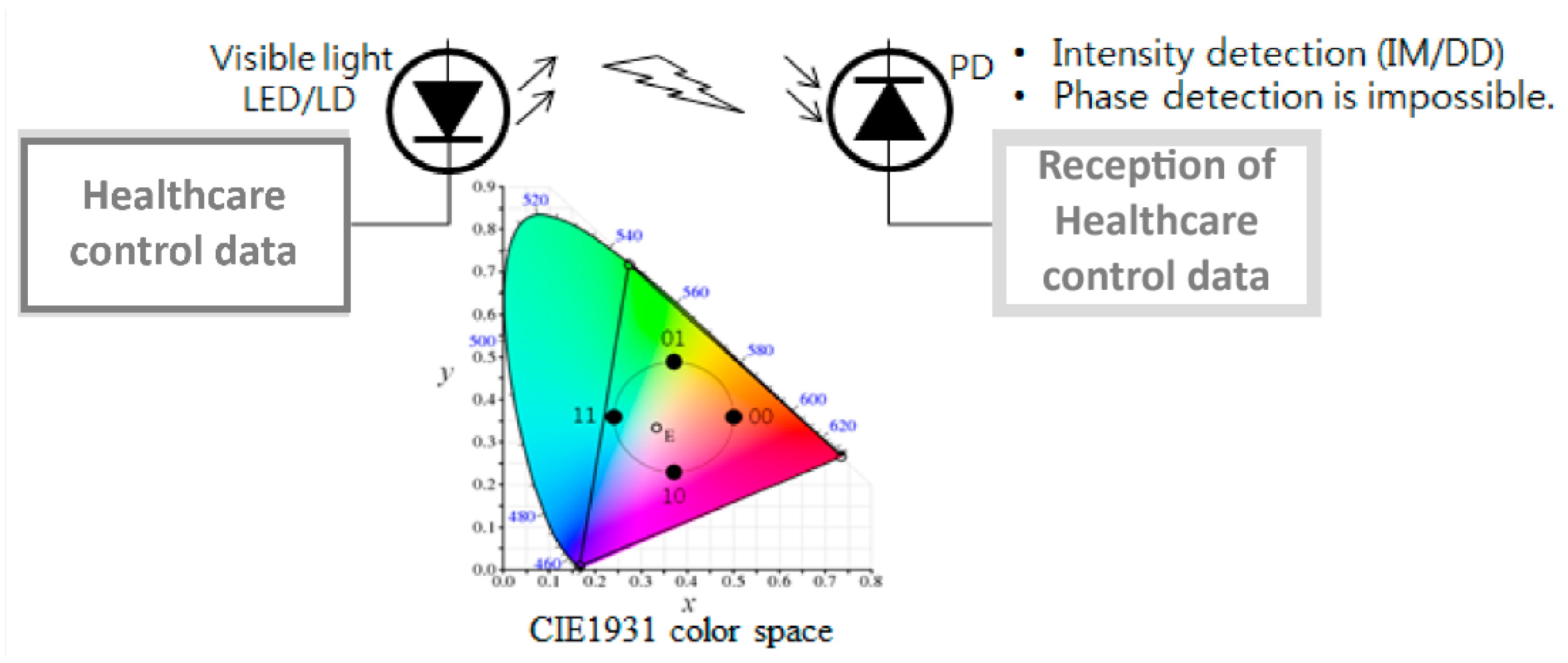
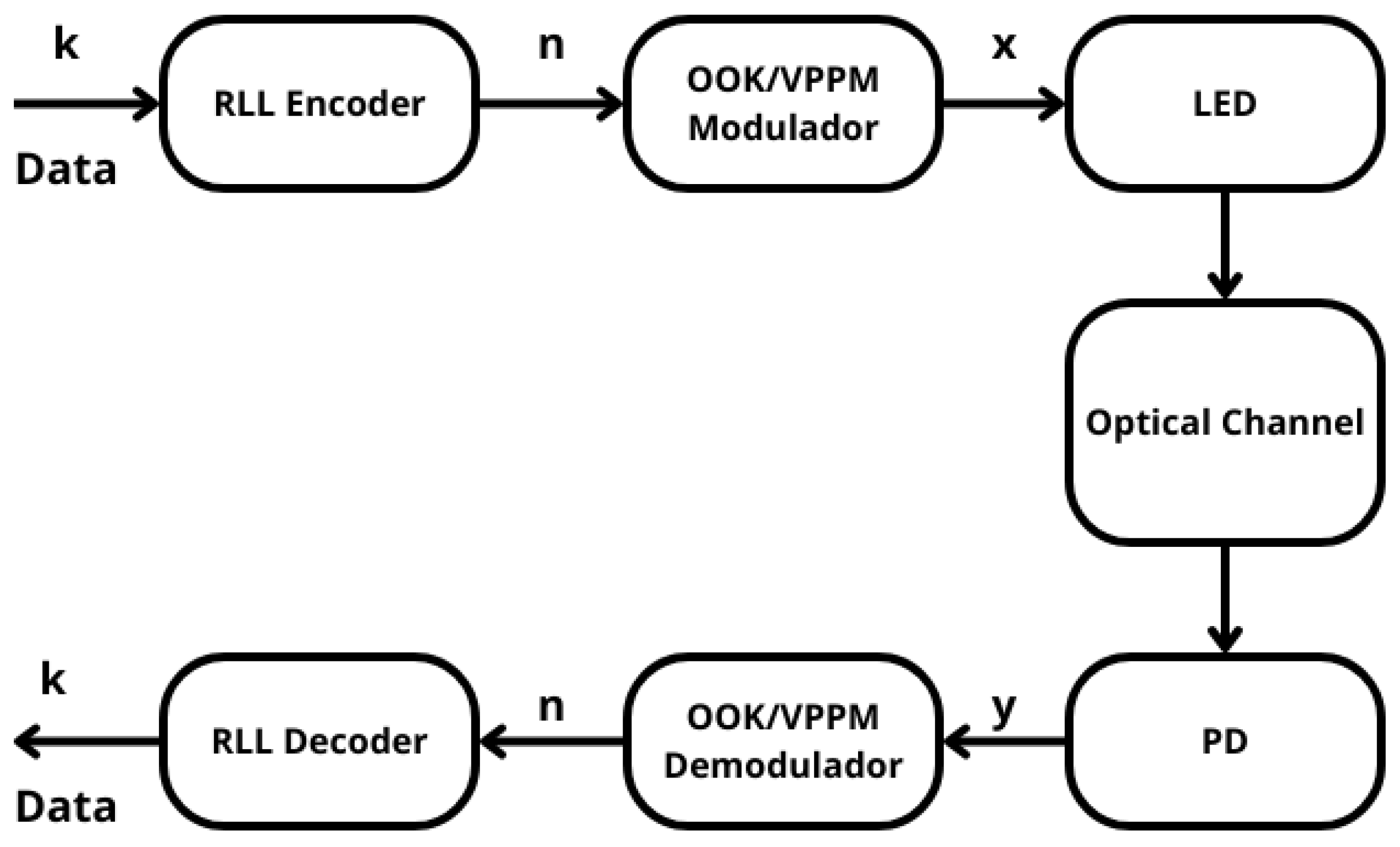
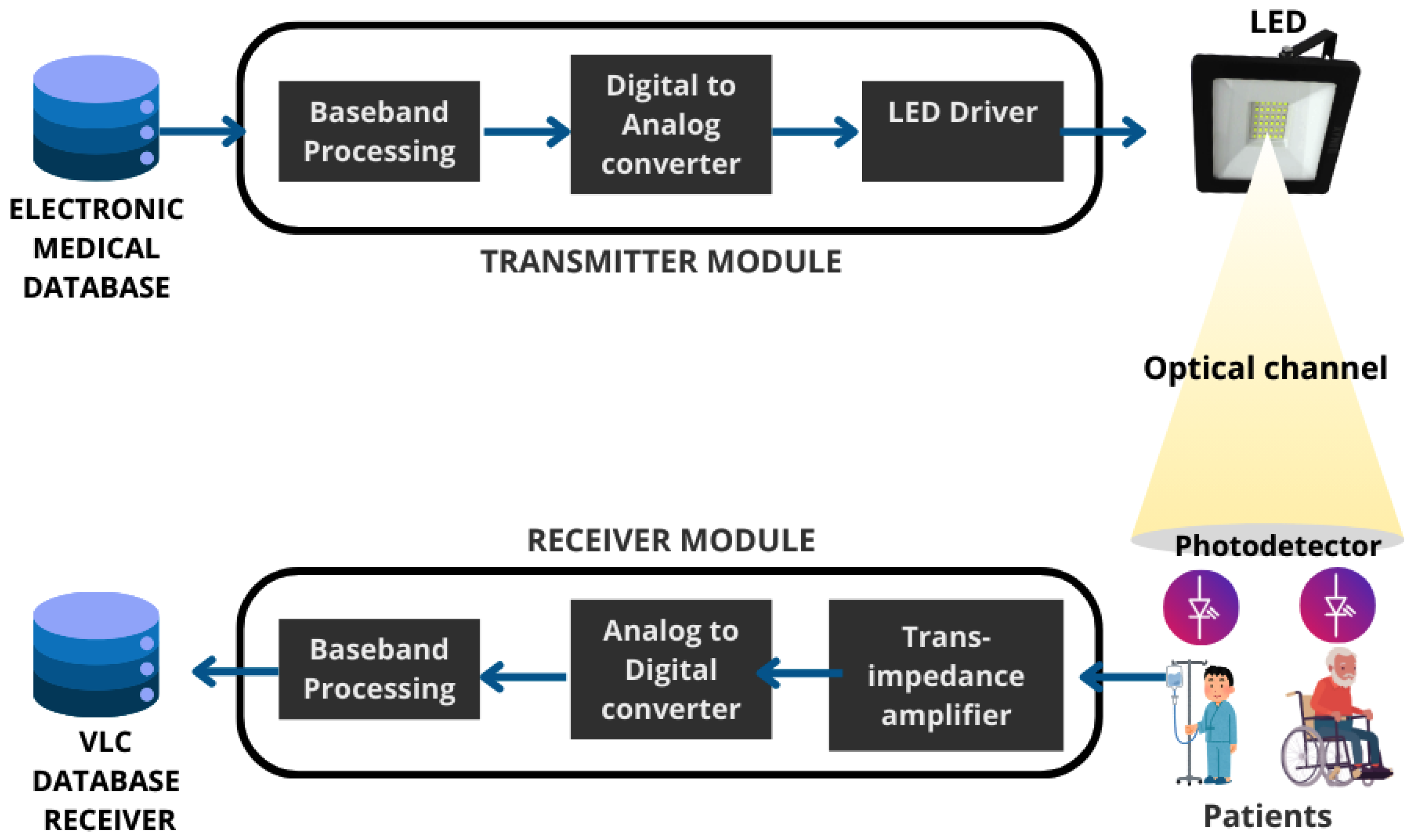
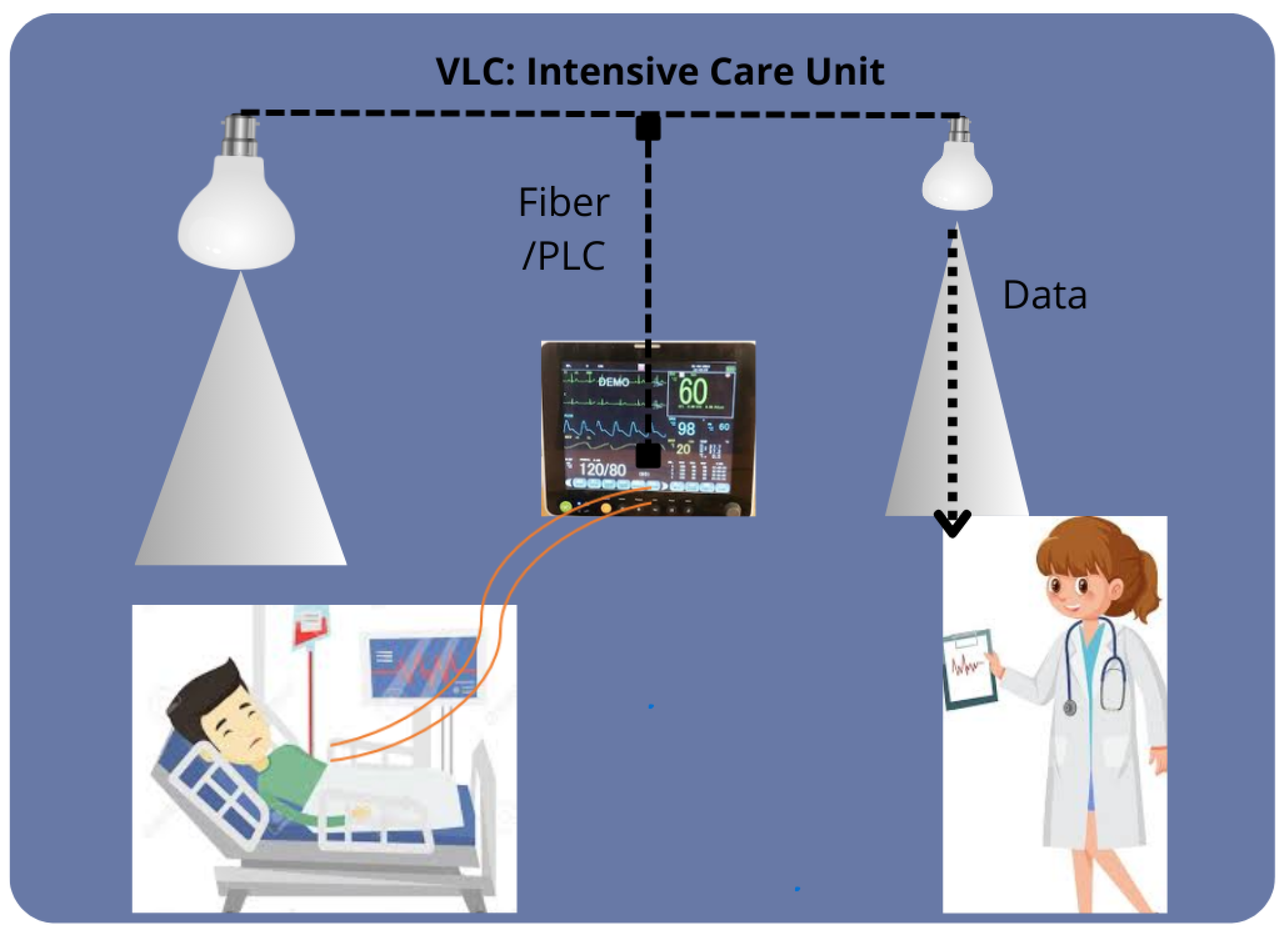
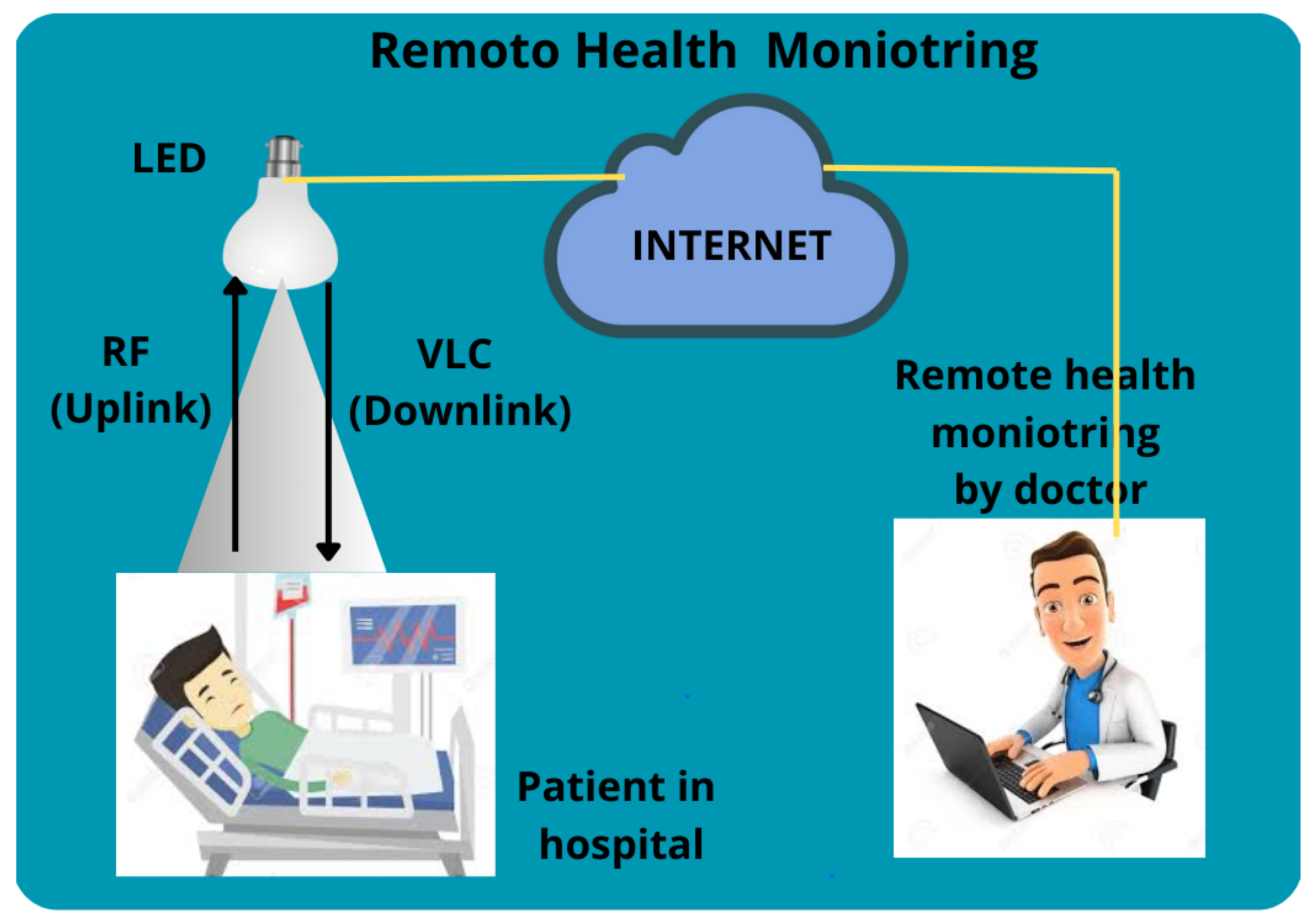
| SI. No | EMF Applications | Healthcare Systems | Health Effects | Ref. |
|---|---|---|---|---|
| 1 | 7 mT, 50 Hz MF for 3 h, ferrous chloride (FeCl2, ), melatonin (0.5 or 1.0 mM). | Rat peripheral bloodlymphocytes in alkaline comet assay. | Melatonin ameliorates the effect of simultaneous exposure to FeCl2 and MF, resulting in significant DNA damage. | [32] |
| 2 | EMF ranges 980, 950 MHz, 200 KHz modulation, 5 w, and 500 ppm toluene applied for two weeks. | MN assay on lymphocytes. | When microwave (mW) radiation was combined with toluene it resulted in significant cytogenetic effects. However, neither MW radiation alone nor toluene alone caused these effects. | [33] |
| 3 | Minimum range of EMF used. | Small area of forearm skin in10 female volunteers is assessed. | Exposure to radiation from mobile phones (MPs) has been suggested to have an impact on protein expression in human skin samples, potentially leading to health effects. | [34] |
| 4 | Two hours per day for 6 months. Frequencies (900 MHz, 1800 MHz and 2100 MHz). | There was a significant increase in DNA damage in the frontal lobe of the rat brain, especially in the 2100 MHz group. | The results indicated that the higher the frequency of RFR, the greater the observed DNA damage and the increase in oxidative stress. | [35] |
| 5 | Medium-frequency EMF. | General medical examination, cardiological, and family history surveys have been conducted for MF broadcast and radio link station workers. | MF broadcast and radio link station workers, which included general medical examinations, cardiological assessments, and surveys on family history. | [36] |
| 6 | EMF ranges like 700 MHz. ContinuousRF-EMF, 25.2–71.0 V/m, 5–15 min. | Slices of rat hippocampus were examined, using evoked field potential measurements. | Reported level of neuronal excitability increase. | [37] |
Disclaimer/Publisher’s Note: The statements, opinions and data contained in all publications are solely those of the individual author(s) and contributor(s) and not of MDPI and/or the editor(s). MDPI and/or the editor(s) disclaim responsibility for any injury to people or property resulting from any ideas, methods, instructions or products referred to in the content. |
© 2024 by the authors. Licensee MDPI, Basel, Switzerland. This article is an open access article distributed under the terms and conditions of the Creative Commons Attribution (CC BY) license (https://creativecommons.org/licenses/by/4.0/).
Share and Cite
Guaña-Moya, J.; Román Cañizares, M.; Palacios Játiva, P.; Sánchez, I.; Ruminot, D.; Lobos, F.V. Comprehensive Survey on VLC in E-Healthcare: Channel Coding Schemes and Modulation Techniques. Appl. Sci. 2024, 14, 8912. https://doi.org/10.3390/app14198912
Guaña-Moya J, Román Cañizares M, Palacios Játiva P, Sánchez I, Ruminot D, Lobos FV. Comprehensive Survey on VLC in E-Healthcare: Channel Coding Schemes and Modulation Techniques. Applied Sciences. 2024; 14(19):8912. https://doi.org/10.3390/app14198912
Chicago/Turabian StyleGuaña-Moya, Javier, Milton Román Cañizares, Pablo Palacios Játiva, Iván Sánchez, Dayana Ruminot, and Fernando Vergara Lobos. 2024. "Comprehensive Survey on VLC in E-Healthcare: Channel Coding Schemes and Modulation Techniques" Applied Sciences 14, no. 19: 8912. https://doi.org/10.3390/app14198912
APA StyleGuaña-Moya, J., Román Cañizares, M., Palacios Játiva, P., Sánchez, I., Ruminot, D., & Lobos, F. V. (2024). Comprehensive Survey on VLC in E-Healthcare: Channel Coding Schemes and Modulation Techniques. Applied Sciences, 14(19), 8912. https://doi.org/10.3390/app14198912







